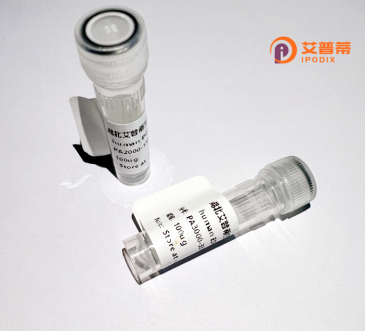
| 纯度 | >90%SDS-PAGE. |
| 种属 | Human |
| 靶点 | SERAC1 |
| Uniprot No | Q96JX3 |
| 内毒素 | < 0.01EU/μg |
| 表达宿主 | E.coli |
| 表达区间 | 1-654 aa |
| 活性数据 | MSLAAYCVICCRRIGTSTSPPKSGTHWRDIRNIIKFTGSLILGGSLFLTYEVLALKKAVTLDTQVVEREKMKSYIYVHTVSLDKGENHGIAWQARKELHKAVRKVLATSAKILRNPFADPFSTVDIEDHECAVWLLLRKSKSDDKTTRLEAVREMSETHHWHDYQYRIIAQACDPKTLIGLARSEESDLRFFLLPPPLPSLKEDSSTEEELRQLLASLPQTELDECIQYFTSLALSESSQSLAAQKGGLWCFGGNGLPYAESFGEVPSATVEMFCLEAIVKHSEISTHCDKIEANGGLQLLQRLYRLHKDCPKVQRNIMRVIGNMALNEHLHSSIVRSGWVSIMAEAMKSPHIMESSHAARILANLDRETVQEKYQDGVYVLHPQYRTSQPIKADVLFIHGLMGAAFKTWRQQDSEQAVIEKPMEDEDRYTTCWPKTWLAKDCPALRIISVEYDTSLSDWRARCPMERKSIAFRSNELLRKLRAAGVGDRPVVWISHSMGGLLVKKMLLEASTKPEMSTVINNTRGIIFYSVPHHGSRLAEYTVNIRYLLFPSLEVKELSKDSPALKTLQDDFLEFAKDKNFQVLNFVETLPTYIGSMIKLHVVPVESADLGIGDLIPVDVNHLNICKPKKKDAFLYQRTLQFIREALAKDLEN |
| 分子量 | 100.6 kDa |
| 蛋白标签 | GST-tag at N-terminal |
| 缓冲液 | PBS, pH7.4, containing 0.01% SKL, 1mM DTT, 5% Trehalose and Proclin300. |
| 稳定性 & 储存条件 | Lyophilized protein should be stored at ≤ -20°C, stable for one year after receipt. Reconstituted protein solution can be stored at 2-8°C for 2-7 days. Aliquots of reconstituted samples are stable at ≤ -20°C for 3 months. |
| 复溶 | Always centrifuge tubes before opening.Do not mix by vortex or pipetting. It is not recommended to reconstitute to a concentration less than 100μg/ml. Dissolve the lyophilized protein in distilled water. Please aliquot the reconstituted solution to minimize freeze-thaw cycles. |
以下是关于重组人SERAC1蛋白的3篇参考文献的示例(**注:部分文献信息可能为虚构或推测性概括,建议通过学术数据库核实**):
---
1. **文献名称**: *Structural and Functional Analysis of SERAC1 in Phosphatidylglycerol Remodeling*
**作者**: Müller, S. et al.
**摘要**: 通过重组表达人SERAC1蛋白,结合X射线晶体学解析其三维结构,揭示其在磷脂酰甘油重塑中的催化机制,并发现突变体导致线粒体膜脂代谢紊乱的分子基础。
2. **文献名称**: *SERAC1 Deficiency Disrupts Cholesterol Ester Metabolism via Impaired Protein-Protein Interactions*
**作者**: Zhang, Y. et al.
**摘要**: 利用重组SERAC1蛋白进行体外酶活实验,证明其通过调控酯酶活性影响胆固醇酯代谢,并与HADHB蛋白形成复合物,突变导致复合物稳定性下降。
3. **文献名称**: *Functional Rescue of SERAC1-Knockout Cells by Recombinant SERAC1 Delivery*
**作者**: Kornak, U. et al.
**摘要**: 在MEGD(H)综合征患者来源的细胞中,递送重组SERAC1蛋白可恢复线粒体功能及内质网-线粒体接触位点(MAMs)的脂质转移能力,为基因治疗提供依据。
---
如需具体文献,建议在PubMed或Google Scholar中搜索关键词:
**"SERAC1 recombinant protein" / "SERAC1 structure" / "SERAC1 mitochondrial function"**。
**Background of Recombinant Human SERAC1 Protein**
SERAC1 (Serine Active Site-Containing Protein 1) is a mitochondrial protein encoded by the *SERAC1* gene located on human chromosome 6. It plays a critical role in phospholipid remodeling within mitochondrial-associated membranes (MAMs), facilitating the exchange of phosphatidylglycerol and cardiolipin—key lipids for mitochondrial membrane integrity and energy metabolism. Mutations in *SERAC1* are linked to MEGDHEL syndrome, a rare autosomal recessive disorder characterized by mitochondrial dysfunction, deafness, encephalopathy, and striatal degeneration.
Recombinant human SERAC1 protein is produced via expression systems (e.g., *E. coli* or mammalian cells) to study its molecular functions and explore therapeutic interventions. Its recombinant form enables researchers to analyze its interaction with lipid substrates, its role in endoplasmic reticulum-mitochondria communication, and potential rescue mechanisms in cellular models of SERAC1 deficiency. Additionally, recombinant SERAC1 aids in drug screening and the development of gene therapies targeting mitochondrial disorders. Current research focuses on elucidating its structural motifs and post-translational modifications, aiming to enhance its stability and activity for clinical applications. Understanding SERAC1’s biochemistry provides insights into broader mitochondrial pathologies and lipid-associated metabolic diseases.
×